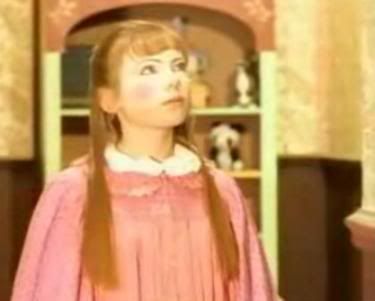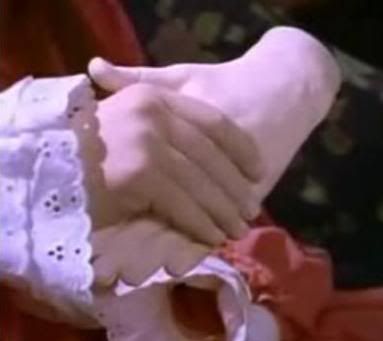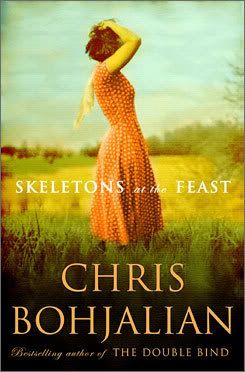
As a child I had a fairly regimented routine. I would go to school and then come home to watch whatever was on Nickelodeon until I had to start homework. Sometimes Hey! Arnold or maybe Rugrats (before the tragic mindfuckery that was All Grown Up! started, mind you) would be on.
But sometimes I wasn't so lucky. No, sometimes Are You Afraid of the Dark? would come on. I could not imagine why anyone would find this terrifying show about things that went bump in the night entertaining. But just because the show scared the bejesus out of me did not deter me from my couch potato tendencies. So what if I was be scared, I wasn't about to start my homework at 4:30.
This weekend I found this very series that plagued me during my younger and more vulnerable years. I posted a link to this review's subject to my Facebook wall, and ELLN was so kind as to share in our former terror. She reviewed the episode that had particularly scared her and I will now follow suit, except that this one scares me for very different reasons.
So without further ado, submitted for the approval of apolloxdaphne and its followers, I call this review "The Tale of the Vampire Town: A Recap from a Traumatized '90's Child."
The infamous opening credits are, arguably, the scariest aspect of the show. Cast in midnight blue the viewer gets such visual scares as a boat rocking all by itself on a lonely lake, a swing swinging with no one on it, the proverbial evil clown doll, and, finally, a hand lights a match to reveal the title of the show: Are You Afraid of the Dark? Music that you would most likely hear on a Halloween CD whilst trick-or-treating with friends plays in the background.
There is an establishing shot of a campfire and we once again are with the Midnight Society.
There is some clunky exposition about some kid in the Society who may not be able to tell the story of the night because he was in a fight at school. But, alas, the delinquent shows up. He is of African American descent and he expresses his disdain for the fact that whatever happens, he is the one who gets some trouble. I am not going to join the YouTube commentators about the racial subtext surrounding this introduction.
The story teller introduces the story by talking about people not liking things that are not normal. He calls the story: The Tale of Vampire Town. Creepy music plays as the Midnight Society fades out.
Thunder, lightening, and wind, oh my! We get a dark and stormy night with a fat man entering a dark and foreboding building. In AYAOTD world this means he's a goner. A phone is ringing and he answers, "Wisteria Funeral Home..." Oh, a funeral home. So far so good. He tells the caller that he was just going out to get the milk.
Instead of going to a nice crowded grocery store, though, he goes into the scary morgue. He opens a coffin to see that it once held someone in it, but zoinks, they're gone. He takes a nice survey of the morgue. A couple of bodies under sheets, nothing special there.
A flash of lightening and finally something terrifying happens. A body that was in the background rises up from its little corner and starts to walk over.
This guy is about to find out that there are worse things than being over fifty and acting in Are You Afraid of the Dark? He's too busy looking for his common sense on the floor to notice a vampire walking toward him.
The vampire's hand gives him what looks to be the Vulcan Nerve Pinch and that puts him out of commission.
Then the vamp sees the cross staring up at him. The vampire screams and runs away, cape flowing in the breeze.
Trippy transition music plays and a voice that you hear in every horror movie tells us that he is arriving in Wisteria, the fabled vampire town. Gothic ye olde handwriting reflects the narration. The voice, clearly that of a deranged vampire hunter from Transylvania, tells us that he is hunting for the vampire known as Dreyfus. Apparently Dracula ain't got nothin' on Dreyfus, because Dreyfus is THE SCARIEST MOST EVIL VAMPIRE EVA!!!! and could kick Dracula's pale scrawny ass in two seconds. The voice vows to meet this vampire, face to face.
The camera pans and we see a boy, who could be the long lost third Corey, clad all in black with dark sunglasses and a ruby broach. "Dad, take it easy," he says in a petulant pubescent voice.
Dreyfus, wherever he is, has got to be shaking in his cape. Corey then amends his common voice by affecting a melodramatic tone with a, "Father, please take care."
His parents, who are actually somewhat tolerable, make fun of their son's obvious hard-on for vampires.
"You know that I only eat red meat," Corey the Vampire Slayer simpers.
His dad further makes fun of him talking about how peanut butter must stick to the fangs.
"If I am going to hunt vampires then I have to think like a vampire and I don't think they eat peanut butter." This kid officially makes it on my list of Kid Characters On TV I Would Like to Murder; he's buried somewhere between Dora the Explorer and Sheen Estavez (of Jimmy Neutron fame). The kid then picks up a magazine with a picture of prevamped Dreyfus on the cover. And you thought I was kidding about the hard-on?
They reach Wisteria, much to the glee of the wee little slayer. His dad is not so thrilled. He has field seats to a sporting event.
His mother sticks up for the little twat, whose name is apparently Adder. Adder? The kid is named after a reptile? At least it drips with wannabe slayer, even if his parents appear to have been suffering a mild case of Downs Syndrome whilst naming their child.
The parents go in the inn and the dad makes a comment about the fact that it is dark. Out of nowhere the innkeeper tells him that sunlight damages antiques. Also sunlight has also been known to damage VAMPIRES.
The innkeeper shows them to their room, and then
Adder has a hissy fit and then says to the innkeeper that he knows that there is an entrance of the catacombs to the basement. He says it like he is blackmailing the innkeeper, but obviously this isn't a big secret if Adder knows about it.
Then Adder notices a door in the background and asks if that is the entryway to the closed catacombs. I wonder if the "No Entry" sign to a level below ground helped him figure it out. The innkeeper asks why Adder is so interested and Adder says, "Let's just say that I have an appointment with destiny."
Adder, meanwhile, plans to find Dreyfus tonight, if He exists.
We cut to a full moon, though I'm pretty sure that's WEREWOLF lore. Adder is downstairs equipped with a flashlight and is making his way to the catacombs. He opens the UNLOCKED door to the catacombs. Yep, this inn doesn't even lock the doors to scary catacombs that house vampires. Stanley and Carl peek out from behind a curtain.
Adder gets down to the catacombs. And blah, blah, blah, corpses and coffins. Scary Latin/Gregorian Chant church music playing. But Stanley and Carl are hot in pursuit, brandishing stakes.
Adder finally comes upon Dreyfus' coffin. He starts taking pictures and giddily explains about how he is going to be famous. Stanley and Carl ambush him. Adder tries to explain that he isn't a vampire.
Then Adder makes the stupidest move in wannabe demon chasing history. HE PULLS DREYFUS'S WOODEN STAKE FROM OUT OF THE COFFIN. For someone who reads about slaying and hunting, he broke rule numero uno, which is DON'T WAKE THE SLEEPING VAMPIRES. Soon we see Dreyfus' coffin show some signs of life.
With Dreyfus awake, Adder realizes that Vampire Hunting is not all that it is cracked up to be, and takes flight.
SUDDENLY, Dreyfus materializes out of nowhere. Did Stephenie Meyer write this episode? Because a whole lot of vampire lore is being violated here.
Dreyfus is about to eat Carl, when Adder's weirdness and "dedication" finally come in handy. He uses some raven's blood to lure Dreyfus away, and then then opens the shades to reveal a very bright sun, which has magically appeared since it was pitch black when Adder left for the catacombs, which in episode time was probably like a half hour for them.
But then we get treated to some horrendous '90's special effects of a computer-generated Dreyfus getting disintegrated by the sun into a pile of ash.
Carl is super grateful to Adder. They have a nice little vindication where Carl warns him that vampires are no joke. Except when they die like that, that was pretty hilarious. Youtube it. (It's really only rivaled by this in my mind)
Adder's parents are, understandably, surprised to see a nice and normal Adder. Gone are the eyeliner and ruby earring. Adder suggests going to the Jets game. His parents are happy.
But Stanley is not so happy. Adder gives him some blood for protection against vampires, and...most people know what's coming, even if you are blind and deaf I still maintain your guessing odds are pretty good. Yep, Stanley is a vampire.
He bites Adder and that's it. Fade to the unimportant Midnight Society as they talk about how "good" the story is. I would protest, but my keyboard has been abused enough already.
I declare this recap closed.






